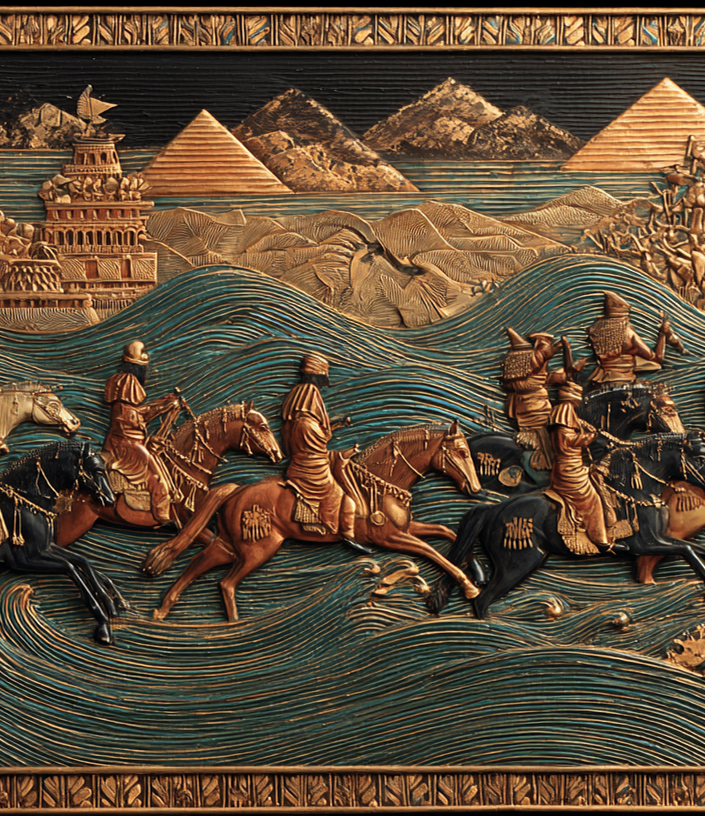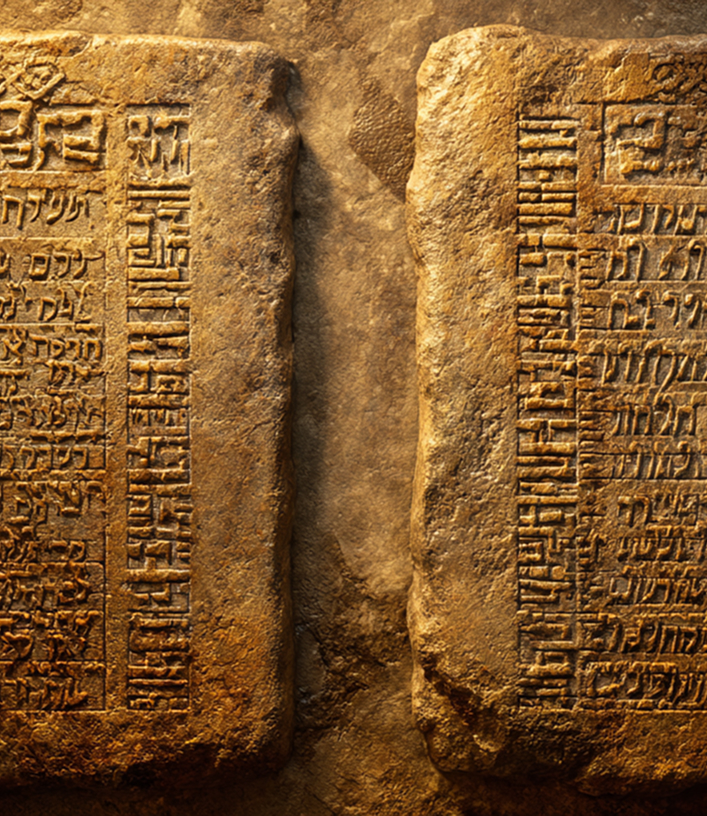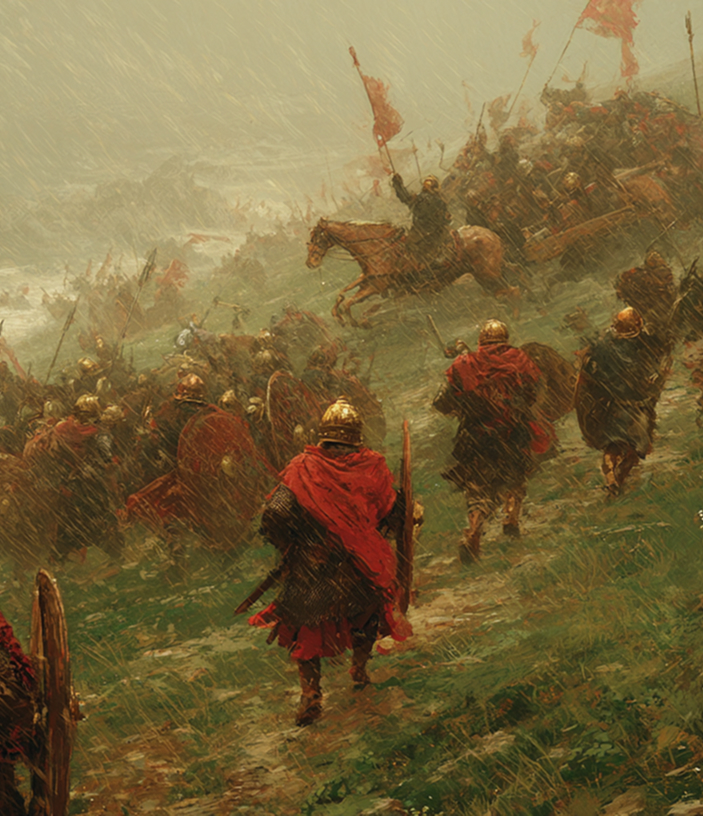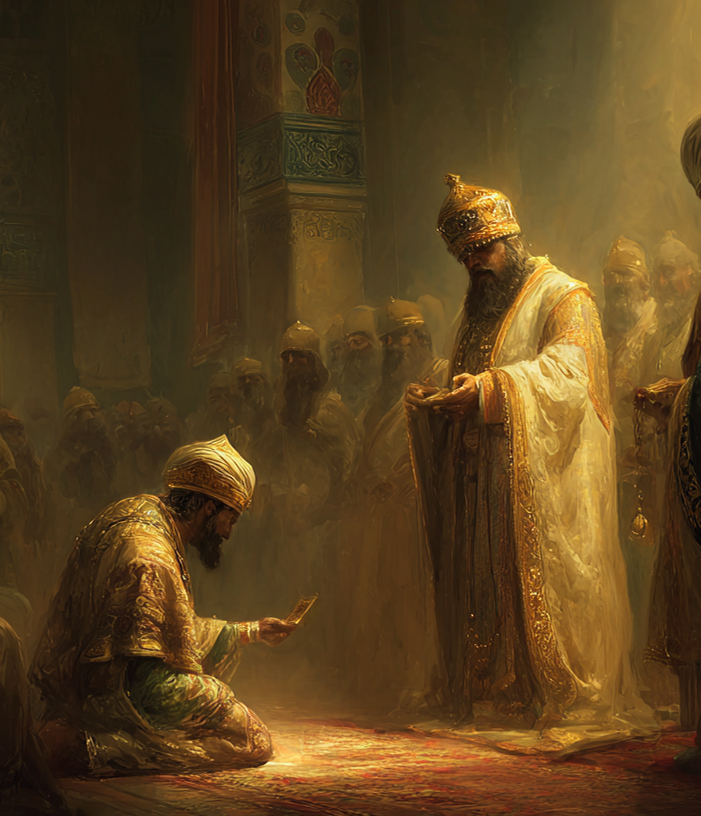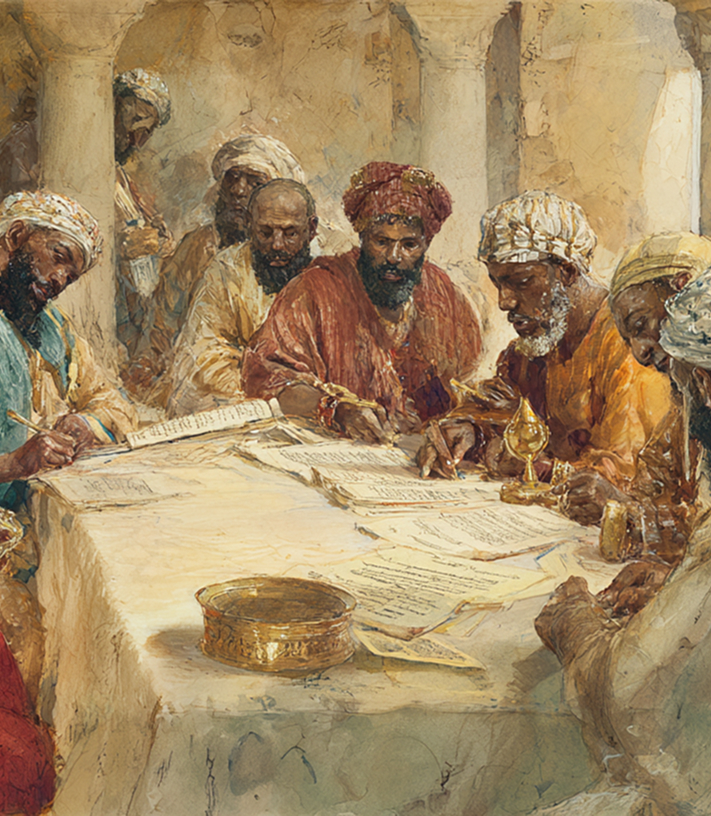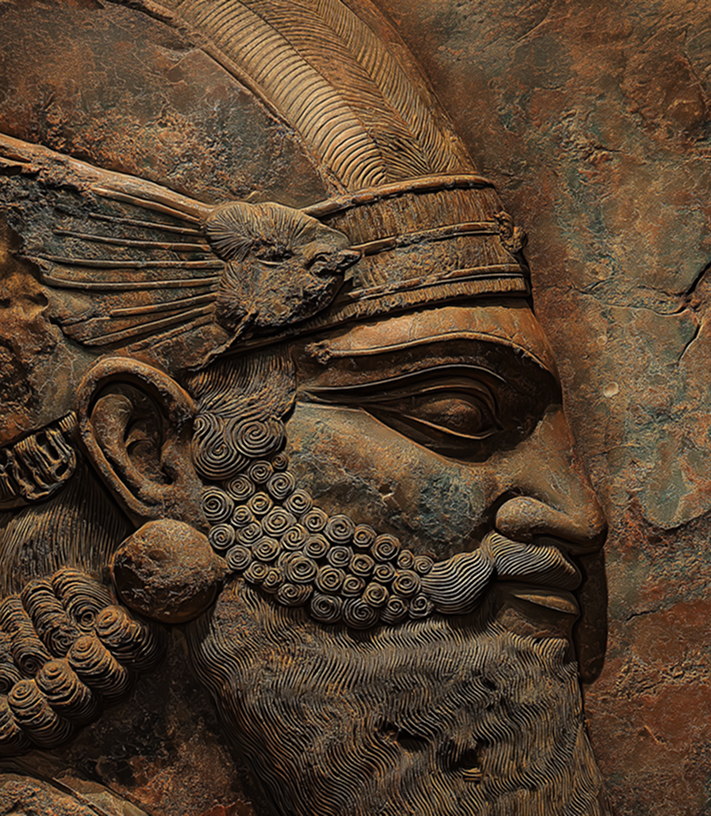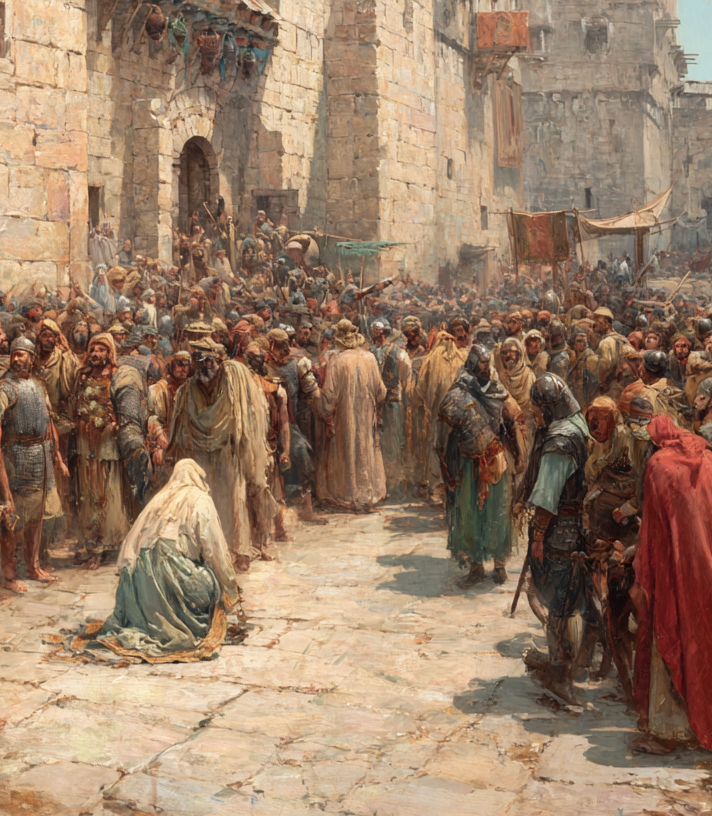Book Introductions
Explore each biblical book with our engaging introductions. To dive deeper, join the community for weekly lessons.
Old Testament
The Old Testament has been studied and analyzed for thousands of years. Even archeological finds, such as the Dead Sea Scrolls, confirm not only written scrolls of the biblical text, but textual commentaries dating back centuries before Christ...but understanding the Old Testament requires investigating cultures far removed from our own and examining challenging belief systems and practices. Ancient Near Eastern and African cultures feature prominently in the Old Testament, as the people of God experience both triumph and tragedy, clinging to eternal promises even in exile. Three primary sections comprise the Old Testament: The Law, The Prophets, and The Historical Books. Filled with complex symbolism and seemingly strange cultural practices, as well as overwhelming violence in the Old Testament can make us hesitant to dive in, but the New Testament cannot be fully understood without the Old. The last prophetic word of the Old Testament marks the beginning of a four-hundred-year stretch of silence, only broken by John the Baptist in the New Testament, inextricably linking the two and giving us a glimpse of a God who is omnipresent.

Genesis
The very beginning… Genesis is not only the very first book of the Hebrew Bible and the Christian Old Testament, but it also serves as both a theological prologue and a foundational narrative for Israel’s identity. Composed over centuries and shaped by multiple sources, Genesis pulls from oral traditions, cultural memory, and theological reflection. Genesis doesn’t just recall facts or names and dates; it tells of God through stories that articulate theological principles such as human responsibility, divine justice, and the persistent grace of God amidst human failure. Themes of murder and incest, betrayal and bloodlust stand alongside stories of tremendous bravery, love and mercy. Genesis doesn’t hold back! We will meet characters that define the entire Old Testament, like Abraham, Isaac, Jacob (Israel), and finally as the book reaches a climax, Joseph. The narrative of Joseph will set the stage for the Exodus but will also leave the children of Israel with the tension of an unfulfilled promise and the hope of what is to come.
Exodus
Exodus is not merely a liberation narrative; it’s a detailed account of covenantal theology. Here God is revealed not as a distant deity but as a liberator, lawgiver, and indwelling presence. Questions of identity are among the foremost themes of the book; who is God and who are we in relation to Him? Positioned as the centerpiece of the Hebrew Bible, Exodus is not just a story of freedom from slavery, but a story about the formation of identity: national, religious, and covenantal. Whereas Genesis tells us how Israel came to be, Exodus tells us what Israel is for. Exodus becomes the “theological grammar” of the entire Hebrew Bible — its message and themes will be revisited in the Psalms, the Prophets, and later in Christian theology as a metaphor of salvation.
Leviticus
Holiness is an elusive concept—one that is at the heart of the book of Leviticus. Often skimmed over by a modern audience, Leviticus can seem overwhelmingly foreign and strange. Dealing with cultural practices involving sacrifice and offerings, as well as instances of judgement and wrath that can be confusing when taken out of context. Whereas Exodus ends with the glory of Yahweh filling the Tabernacle, Leviticus begins by explaining how that divine presence can be sustained amidst errant human beings. It’s not just a book of ancient rituals — it’s a manual for living in relationship with the only One who is truly holy. Strange fire, literal scapegoats, and ritual purification are just a few examples of important truths that can masquerade as irrelevant ancient customs. Leviticus may be an ancient book, but it’s full of modern relevance. And in a world where holiness is so often misunderstood, Leviticus holds crucial lessons for how we ought to live in relationship with a holy God.
Numbers
Behind the name (taken from the Greek Arithmoi, referencing the censuses contained in Numbers) lies a deeply theological and surprisingly narrative-rich book. The Book of Numbers tells the story of the generation that left Egypt and their descendants who are on the verge of the Promised Land. In Hebrew, the book is more aptly titled B’midbar — “In the Wilderness” — which captures its tone and purpose. The book of Numbers is all about life in transition, about a people caught between a promise and a Messiah, and about how God forms a nation not just by delivering it from slavery, but by shaping it through trial, failure, and covenantal discipline.
Deuteronomy
Most read Deuteronomy as a book of law, but it’s much more than that…The final book of the Pentateuch, Deuteronomy frames the story of Israel not just as a historical journey, but as a rallying cry to covenant faithfulness in every generation. Contained in Deuteronomy are Moses’ final speeches. In this way, much of Deuteronomy is a long sermon. Yet, although much law is given, Deuteronomy is not legalistic; it’s emotional, moral, and relational. The repeated call is to “love the LORD your God with all your heart, soul, and strength.” The emphasis is not on obedience out of rigid rules, but real relationship. There’s also deep concern for the marginalized: the widow, the orphan, and the foreigner. Laws about debt release, fair treatment of workers, and just leadership reflect a vision of a fair society grounded in memory; because Israel was once a slave nation, it must never become an oppressor. Serving as the foundation of the Deuteronomistic History (the books of Joshua through Kings) Deuteronomy’s influence is profound, shaping later prophetic voices (like Jeremiah) and echoed in the teachings of Jesus, who quotes Deuteronomy more than any other book.
Joshua
The book of Joshua picks up where Deuteronomy ends: Moses is dead, and leadership has passed to Joshua, Moses' protégé and military commander. Now, a new generation must move from promise to possession… This is a story wrapped in violence, covenant, and hope — it is a book that wrestles with identity, obedience, and the cost of inheritance. At once triumphant and sobering, Joshua is a theological history, not a modern war chronicle. It reads like both a victory hymn and a warning. Deuteronomy wrestles with complex questions and the wartime narratives are a source of much debate and questioning, especially in modern times. Themes covered include inheritance, warring conquest, and inclusivity—none of which can truly be answered on a surface level.
Judges
One of the most haunting books in the Hebrew Bible, Judges chronicles a dark period in Israel’s history. Prone to stray, Judges exposes the frailty of the human condition and how easily mankind wanders from God. Though a cycle of sin leading to oppression, requiring God to miraculously redeem not only repeats but spirals in an overtly downward trajectory throughout the course of the book, certain characters emerge as beacons of hope. Among them are Deborah and Gideon. Still others, like Samson, represent the complexity of a narrative that features flawed people crying out to a Holy God. The Book of Judges is ultimately an unsettling read but therein lies the purpose. God’s children are repeatedly shown to have forgotten their history, strayed from their covenant, and abandoned justice. The book of Judges demonstrates the consequences of a life void of true leadership and the author’s message is clear.
Ruth
The book of Ruth stands out in the realm of ancient literary compositions for many reasons, not the least of which is the masterful storytelling. Few manuscripts of this era incorporate so much plot development and dialogue. Within Scripture there are other similar historiographic short stories, such as Joseph in the book of Genesis, or Gideon in Judges, but Ruth stands alone whereas the others have been absorbed into a larger overall composition. Following immediately after Judges, a book marked by violence, chaos, and moral collapse, Ruth offers a quiet, redemptive counter-story; one that takes place on a small scale but speaks volumes about loyalty, providence, and divine faithfulness. The stark contrast between the characters and actions of the book of Judges with the book of Ruth serves as a reminder of what it looks like when God’s people remain in Him. Though we will examine criticisms the character of Ruth has received over the course of history, unchanging is the fact that the narrator uses Ruth to demonstrate what faith in action looks like. Faith isn’t emotion. Though you may not have an in-person experience with God like Moses or Abraham, Ruth shows what faith looks like when lived out. And it is faith that allows Ruth to remain at the center of God’s plan—one that ultimately results in the birth of the Messiah.
1-2 Samuel
Though now broken into two, 1-2 Samuel were originally one Hebrew book. A historical narrative that spans the end of Israel’s Judges on through King Saul and the anointing of King David. Although the book shows a fractured tribal nation moving toward an organized monarchy, the author doesn’t shy away from the dark side of power. 1–2 Samuel speaks to enduring questions about leadership, justice, and the tension between divine sovereignty and human agency. It delivers a nuanced portrait of political power, showing how deeply flawed people can still be used in meaningful, even redemptive, ways. For religious readers, it lays foundational ideas about God’s involvement in history and the promise of a messianic king.
1-2 Kings
1 Kings opens with the death of King David and his heir, King Solomon taking the throne. Though the nation will prosper under Solomon, their prosperity won’t last, and 2 Kings will close with destruction of Jerusalem and the Babylonian exile. The narrative, however, is more than a political chronicle—it’s a theological interpretation of Israel’s history through the lens of covenant faithfulness. It evaluates each king, not by political success, but by their loyalty to God and showcases what happens to a society that abandons their moral code. 1-2 Kings lay the groundwork for prophetic hope during exile and set the stage for the prophetic literature and the eventual hope of restoration.
1-2 Chronicles
Though it never contradicts, 1-2 Chronicles tells essentially the same history as 1-2 Kings, but with an entirely different purpose. Tracing the genealogies back to Adam, the author of 1-2 Chronicles offers a message of hope and restoration to a community in exile, wondering if God has abandoned them. 1-2 Chronicles emphasizes that the past still matters, but that God’s promises endure.
Ezra
Ezra is a raw and deeply human account of a community wrestling with how to start over after failure. Written from a place of post-exile, Ezra details how the Israelites renew their covenantal faithfulness in a world where God’s people are a small, vulnerable minority under imperial power. It wrestles with questions about holiness in a pluralist, secular society. Ultimately the book of Ezra raises questions that we are still asking to this very day.
Nehemiah
Written in first-person, Nehemiah is the account of a high-ranking Jewish official in the Persian court who is moved by the broken state of Jerusalem. With the king’s permission, he returns to lead the rebuilding of the city’s walls, defending against external threats, and implementing social and religious reforms to restore the people’s identity and covenant with God. Nehemiah is a book full of loss, trauma, and personal failure, all of which the prophet uses to equip a reader with valuable and applicable lessons, still relevant today.
Esther
Much more than the tale of a beauty queen, Esther is a literarily advanced historic novel. The book of Esther tells the story of a Jewish woman living under Persian rule who becomes queen only to then risk her life in order to save her people from annihilation. The book is set during the Jewish diaspora, when many Jews lived outside of Israel, under foreign rule. It's a story of survival, identity, courage, and providence, told with dramatic tension, irony, and a strong moral arc. Though God is never named, the narrative is saturated with theological meaning: it invites readers to see divine providence at work behind the scenes, even in a world that feels secular or hostile.
Job
One of the most intellectually challenging and emotionally powerful books in the Bible, Job offers an intimate look at the purpose and meaning of pain. Through the account of a man who loses everything, we glimpse the intimate and personal nature of a God that exists in relationship with man without compromising His sovereignty. Furthermore, Job showcases that to mourn is not weakness, and questioning God is not rebellion. This account demonstrates that the most faithful thing we can do is to press on, speak honestly, and wait in trust—even when the heavens are silent.
Psalms
Featuring both the longest and the shortest chapter in the Bible, Psalms is more than a book of poetry. Traditionally attributed to David, there are numerous authors throughout the book of Psalms. Showcasing a full range of emotions, each carefully crafted poem articulates an aspect of God, while simultaneously providing a reader with a tool for remembering the insight.
Proverbs
Though deeply theological, Proverbs is also incredibly practical. Mainly attributed to King Solomon, Proverbs provides the written account of many ancient words of wisdom to live by—tools for navigating everything from temptation, to work, and even relationships. While Proverbs assumes a relatively stable, ordered society where justice can prevail and effort often pays off, it doesn't ignore life's complexities. It provides guidance, not a formula, and a modern audience must take into account the wisdom literature surrounding it in order to fully appreciate its complexity.
Ecclesiastes
Many believe the book of Ecclesiastes to be written in response to the ancient Epic of Gilgamesh where the mythological hero famously concludes that “life is meaningless.” This question is carefully examined by the author of Ecclesiastes and not easily dismissed. Questions like, “why does evil seem to win?” or “why do bad things happen to good people?” pervade the author’s discourse. Existential questions abound, and there is a grappling with the problem of evil that is perhaps more direct than any other book in the Bible. Ultimately, however, the author concludes that life is meaningless—but only when separated from God’s plan. It’s only when we align ourselves with His purposes that life becomes more than any one individual existence.
Song of Songs
One of the most provocative books in the canon of Scripture, Song of Songs has been a source of debate since the early centuries. A love song, or mere metaphor? A poem from a lover to his bride, or for the Bride of Christ? These are questions we will examine as we unpack the sexually charged metaphors that compose the majority of Song of Songs.
Isaiah
One of the three longest prophetic books of the Bible, Isaiah is one of the most theologically rich and literarily engaging books in the canon. It moves from warnings of judgment to visions of restoration, from historical crises to future hope, and from earthly kings to the promised Messianic King. The most quoted of the Old Testament books in the New Testament, it is often called the “fifth gospel” because of its deep influence on Christian theology. Some of its most vivid imagery include portrayals of the suffering servant, the coming of a child-king, and the renewal of creation.
New Testament
The New Testament—or New Covenant—is one of the most profoundly disruptive documents in world history. The birth of Christ marks even the beginning of a new era of time—A.D. Anno Domini. Written in the mid-late first century, the New Testament connects the birth of Christ to the messianic prophesies of the Old Testament, and so much more. As we journey through the accounts of firsthand eyewitnesses, relatives of Jesus and even enemies turned into allies, a story unfolds of epic proportions. Journey into a world full of political tension, superstition, and a world rife with polytheism and cultic ritual. Written amidst the violent rule of the Roman Empire, the threat of death or torture is ever present. In fact, most New Testament authors will be martyred for their faith. It is in this hostile environment, however, that each author produces the theological masterpieces that define Christianity even today.

Matthew
Written by a tax collector, the book of Matthew was written primarily for a Jewish audience. The author beautifully bridges Jewish tradition and the emerging Christian faith, emphasizing Jesus’ fulfillment of the Messianic credentials. One of the three Synoptic Gospels, Matthew provides an extensive genealogy, as well as a thorough account of Jesus’ life and ministry.
Mark
The second of the Synoptic Gospels, the gospel of Mark is attributed to John Mark (called Mark) who is not one of the original 12 disciples. It is a widely held belief that it contains much of the source material for the other two Synoptic Gospels, Matthew and Luke. Mark’s intended audience was primarily Gentile and this gospel book was written during an intense period of persecution of early Christians. His narrative is fast-paced and action packed! And he describes in tremendous detail the suffering Jesus endured in the final week of his earthly life. What Mark offers is a tangible and raw account of the passion Jesus demonstrated, despite the conflict and adversity he faced during the course of his ministry.
Luke
The third of the Synoptic Gospels, Luke’s account deals largely with the marginalized figures of society. In this way, his gospel pairs with the book of Acts as Luke delivers a holistic view of the emerging Christian church. Although Luke was likely a Gentile (and not a member of the original 12 disciples), he writes in such a way as to explain the importance of Jewish traditions and customs as they pertain to the Messiah. His sensitivity to often overlooked members of society showcases a facet of Jesus’ ministry that would prove far more disruptive than any militant action could.
John
With an emphasis on what scholars refer to as “high Christology,” John’s gospel differs from the three Synoptic Gospels in its attention to Jesus as God. This is not to suggest that John’s account contradicts Matthew, Mark, and Luke, but rather that whereas the Synoptics illustrate Jesus’ humanity, John showcases his divinity. In this way, the four gospels give us a fuller understanding of a god who became flesh in order to redeem his creation. John follows Jesus’ life closely, but he highlights seven key miracles in particular, revealing Jesus as divine. John also makes a point of delving deeper into the theological profundity of Christianity—providing reflection for religious leaders (both Christian and Jewish) who were facing tremendous pressure at the time.
Acts
“You will be my witnesses in Jerusalem, in all Judea and Samaria, and to the ends of the earth…” The book of Acts marks the very beginning of Christian history. Written in a turbulent political climate, amidst the persecution of deranged emperors, the book of Acts chronicles the challenges faced by the earliest Christians as they attempted to navigate what the resurrection truly meant. Themes of the Holy Spirit, what it means to live a holy life, and community with those who come from dramatically different backgrounds fill the pages. As we follow Luke’s narrative, we encounter places such as Akeldama, the Beautiful Gate, and even Herod’s palace where Paul is placed under house arrest. Throughout Paul’s three missionary journeys, we will also examine the world of ancient Rome—full of pagan religious cults, including the cult of Aphrodite, the Delphi Oracle and many others. These will all provide important theological insights that remain relevant even today.
Romans
Authored by Paul, this letter to the Roman church is addressed to a largely Gentile audience. This impacts Paul’s approach, as he frames his explanation of God and righteousness within the context of Greco-Roman cultural practices. Paul navigates the tension that the Jewish-Christians in this congregation would have been feeling carefully and offers a modern reader tremendous insight as to how to properly address internal conflicts and areas of cross-cultural sensitivity. This is not a lighthearted message; themes of greed, pride, and sexual impurity are on Paul’s mind as he writes his Roman brothers and sisters.
1-2 Corinthians
Written approximately a year apart, 1-2 Corinthians chronicle one of Paul’s more challenging relationships with the churches. Though Paul was successful in establishing a church at Corinth, he at times struggled with how to reach the culture of Corinth. 1 and 2 Corinthians form a compelling portrait of a first-century church and what it was like navigating theological confusion, ethical challenges, and the tension that inherently comes with leadership. Paul’s responses are both theologically rich and pastorally sensitive, offering timeless guidance on church unity, spiritual maturity, and the nature of Christian leadership. These letters remain foundational texts for understanding early Christianity and the lived reality of the gospel in community.
Galatians
One of Paul’s harshest letters, Galatians was written as a loving rebuke. Addressed to the churches in Galatia (modern-day Turkey), the letter responds to a crisis: namely that the gospel was being twisted. In fact, Paul himself had come under fire and was being slandered. But Paul’s letter isn’t a defense of himself; he’s writing to defend the truth and clarify for these early believers that faith in Christ alone saves. It challenges both legalism and syncretism and illuminates what an identity in Christ truly means.
Ephesians
Written to the church at Ephesus, the letter itself is far broader in content than any of Paul’s other correspondences. This is likely due to the position of Ephesus as a major trade route—strategically positioned and accessible to people from all over the known world. Rather than addressing specific controversies or crises, Ephesians offers an eloquent vision of God’s eternal plan in Christ, emphasizing unity, spiritual identity, and ethical living in light of the gospel.
Philippians
Written to a proudly Roman town, rich in gold and silver mines, Paul’s letter to the church at Phillipi emphasizes humility and joy amidst suffering. In this letter, Paul will use many distinctly Greek and Roman references to illustrate his message and allude to his almost certain impending death. In this brief book, Paul provides a vision for a life in Christ—one that maintains a fixed gaze on eternal purpose.
Colossians
Authorship of Colossians has been hotly debated. Ironic for a book that deals largely with the false teachings that arose in Colosse. In Colosse, believers were being influenced by teachings that mixed Christian faith with elements of Jewish legalism, Greek philosophy, mysticism, and ascetic practices. Paul (possibly Timothy or other apostle) writes for the purpose of clarification. In this letter, Paul adamantly defends the supremacy of Christ and the finished work on the cross.
1-2 Thessalonians
1-2 Thessalonians may be brief, but these letters have been referenced by early church writers dating all the way back to the second century. Written in approximately 51-52 A.D., Paul is addressing the church at Thessalonica. One thing that Paul is clearly seeking to do in his letters is to encourage the church in Thessalonica, as well as provide further teaching for new believers. Although facing an incredible weight of persecution, they were still faithful and growing. But Paul knows this is only the beginning—he’s very aware of the severe persecution they will inevitably face. He doesn’t shy away from the hardships and trials they will likely endure. In fact, this theme will actually grow in sense of urgency as we move from 1st to 2nd Thessalonians and the persecution the church faces increases. However, Paul makes clear that this opposition is actually all part of God’s plan and he teaches them how to use it to make them stronger.
1-2 Timothy
Timothy presents a unique character in the New Testament—first appearing in the book of Acts. Timothy joins Paul’s mission team early on, and they quickly form a bond. Paul refers to him as a “son” and diligently disciples him. In the books of 1-2 Timothy, we see that he is in need of encouragement, and these letters not only combine personal encouragement, but also pastoral instruction, and warnings against false teaching. No doubt due to the fact that Paul’s own fate was looming close, these letters strike an emotional tone. This is Paul’s final letter, written from prison in Rome, likely under sentence of death. In this deeply personal farewell, Paul urges Timothy to remain faithful, endure suffering, and carry on the gospel mission. He offers a vision for church leadership, sound doctrine, and faithful ministry in the face of both external challenges and internal threats.
Titus
Written by Paul and delivered by Zenas and Apollos, this brief letter is dense with words of wisdom and instruction. Titus was a valued associate of Paul, but he was entrusted with a difficult task, leading the church on the island of Crete. This island was known for moral depravity and finding leaders among them has clearly presented a challenge for Titus. Paul writes, not only to encourage, but also to advise Titus. In his letter, Paul makes many cultural and geographical references that have significant theological implications. A mere 3 chapters long, Paul provides a wealth of insight.
Philemon
Written by Paul, the book of Philemon is uniquely personal. In this letter, Paul is addressing a friend on behalf of a runaway slave. Paul refers to himself as a “slave of Christ” as he urges Philemon to “do what you ought to do.” In a single chapter, Paul paints a picture of a radically different social order, and he undermines the entire system of slavery in only a few short words. Furthermore, Paul depicts a sort of heavenly family dynamic that is devoid of hierarchy or class—instead it is fully submitted to the will of God.
Hebrews
The author of this brief book is unknown. What we do know is that the author was a friend of Timothy’s, spoke fluent Greek and was well educated in the Old Testament. There is a sense of urgency in the author’s tone, likely because at the time Hebrews was written, persecution was a very serious concern. Like the author, the audience of Hebrews has also been debated. Most likely written to Hellenic Jews, the title of “Hebrews” was not part of the original text. The author stresses the importance of the New Covenant and the superiority of Christ and pays attention to compromises being made in both Jewish-Christian and Gentile-Christian environments.
James
Addressed to the “twelve tribes,” most attribute the book of James to Jesus’ brother. The inclusion of all twelve tribes is significant for this moment in history, and the author bears an especial burden that the earliest disciples openly shared. This letter is strongly worded, containing many exhortations to live a moral and upright life. James does not hold back—he makes clear that as believers, we are called to a higher standard.
1-2 Peter
The authorship of 1-2 Peter has been a source of much debate—largely due to the fact that Peter is elsewhere referred to as “simple” or “unschooled.” But these arguments ignore the more likely implication that Peter was simply not “college educated.” He was, however, a businessman (fisherman by trade) which would have required literacy and a knowledge of Greek. Furthermore, Peter specifically mentions that he enlisted the assistance of Silas in writing the letters. Much of 1-2 Peter has been taken out of context in modern times and thus, caused confusion and at times, division. Written to scattered believers in Asia Minor (modern-day Turkey), these letters address Christians living as exiles in a hostile world and offers practical advice for remaining unpolluted by society. While 1 Peter focuses on encouragement amid suffering, 2 Peter warns against false teachers and urges believers to remain faithful as they await the return of Christ.
1-2-3 John
The three Johannine Epistles (1 John, 2 John, and 3 John) are traditionally attributed to John the Apostle, the “beloved disciple,” who also authored the Gospel of John. These letters reflect the theology and style of the Fourth Gospel and are deeply concerned with truth, love, obedience, and fellowship with God through Jesus Christ. While 1 John reads more like a theological sermon or pastoral tract, 2 and 3 John are brief, personal letters written to specific individuals or communities. Together, they address issues of false teaching, Christian identity, love, and church relationships in the late 1st century.
Jude
Full of Old Testament allusions and Jewish apocalyptic imagery, The Epistle of Jude is a short but powerful letter. Written to warn believers against false teachers who had infiltrated the church, Jude urges the faithful to “contend for the faith” and remain steadfast in truth, holiness, and love. A mere 25 verses long, Jude overflows with exhortation and encouragement for a church facing opposition on all sides.
Revelation
One of the most literarily complex books ever written, scholars are still puzzling over the depth of meaning packed into these 22 chapters. Written from exile on the island of Patmos, John records heavenly visions and apocalyptic messages for the seven churches of Asia Minor. These churches were facing levels of persecution that suggested the end times to be near and John’s words no doubt provided strength and encouragement. The Book of Revelation offers a climactic vision of God's ultimate victory over evil, calling the church to faithfulness, courage, and hope. While its symbolic language can be challenging, its central message is clear: God is still in control, His presence is eternal, and He is coming back.


